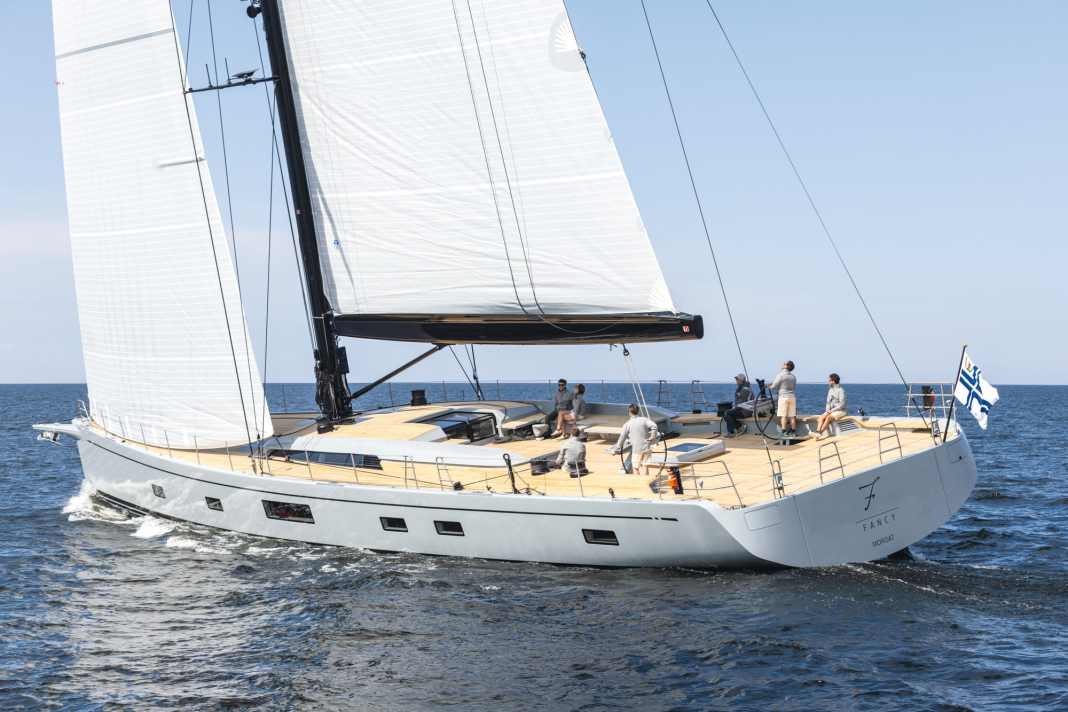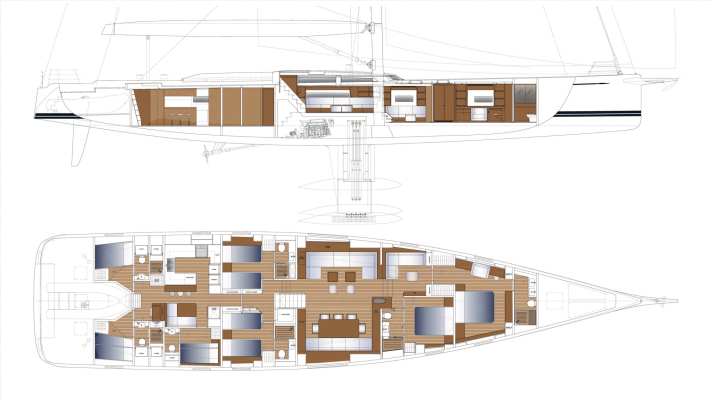





As chic as the name and appearance are, the maiden voyage of the first Swan 108 was a rough one: the transfer from Pietarsaari in Finland to Mallorca was a baptism of fire for "Fancy". Initially, the 36-metre maxi was hit by capricious weather conditions. The shipyard told "Fancy" captain Eric Santene not to overdo it. His interpretation was a ride through the North Sea with two reefs in the main, staysail and permanently just under 20 knots. A depression over the English Channel then forced them to weather it out for two days in Amsterdam. As the captain didn't like the trim of the mainsail, he set it in the centre of the city. Surrounded by canals, 344 square metres of North Sails laminate roared up the almost 50 metre long mast. This attracted attention and was promptly reported to the harbour police, who were not amused by this kind of flag parade.
The shipyard wanted the skipper to take it easy. His reading: two reefs, staysails and almost 20 knots
The anecdote is told by Santene in the cockpit and with 8,000 nautical miles in her wake, about half of which are attributable to the 15-day crossing. For the actual christening, they turned off in Brest and left nothing to chance. The Frenchman imitates the rapid movement of a hammer and reveals how he prepared the christening champagne: "There was a small crack and I hardly dared to touch the bottle." The Bay of Biscay showed its tame side, but danger still lurked in the Mediterranean. To prevent orca attacks, he stayed close to the coast. Tension was high, buckets of sand were ready, after all, the first charter booking for August had already been accepted and they didn't want to risk any damage to the rudder. Everything went smoothly, and on entering Palma the log showed an average speed under sail of eleven knots.
More from the shipyard:
- ClubSwan 28: YACHT test of the smallest series boat built by Nautor
- ClubSwan 36: A sophisticated fun machine
- Test ClubSwan 43: A real racer and yet a cruiser - can it work?
- Swan 55: Finest Finnish - pretty close to perfection
- Nautor creates sailing self-sufficiency with Swan 88 thanks to electrification
- Swan 115 FD: Simply beautiful - 35 metre slup "Shamanna"
- "Tarantella": Ur-Swan lays foundation stone for exceptional Nautor shipyard
Evolution instead of revolution
With the Swan 108, Nautor initiated the reorientation of the maxi line. The 88 and 128 are the next to follow the new design direction, as Vanni Galgani, Head of Product Marketing, says: "As always with Swan, we are continuing to develop, but we are not revolutionising, that's what we have ClubSwan for. The new Maxis take the best from the 98 and 120 and are in line with the existing models. On the design side, the volume distribution in the hull has been improved and the sail area has been consistently redistributed."
Since 1980, Germán Frers and his design team have been shaping the swans of the Cruising line, which starts at 48 feet. Frers Senior has designed a total of 30 different maxi models for the Finnish shipyard with Italian management. Galgani even calls the Argentinian "Master of the Maxis". Nevertheless, Frers received design support from Milan-based studio Micheletti + Partners for the 108 for the first time. Architect Lucio Micheletti, who earned his design spurs in the automotive segment and has already worked for shipyards, created a dynamic superstructure that is visually elongated by a seemingly floating coaming. The trick: Micheletti created a gap between the teak and grey carbon coaming. This eliminates the practical seat and step, giving the ensemble an open and elegant appearance. Compared to the Swan 115, which was built four times, the deck is more pronounced and the stern is significantly wider. And Micheletti even brought back a Swan signature that had disappeared: the soft transition from the transom to the bulwark in the form of a half-arch.
The carbon mast was moved to the flat superstructure roof for more propulsion through the foresails. Nautor uses Sprint technology from the Swiss composites group Gurit for laminating. This also involves prepregs, i.e. fibres pre-impregnated with resin, which have to be stored deep-frozen, processed individually and precisely and only harden in a vacuum at an elevated temperature. But unlike conventional prepregs, the carbon fibres completely enclose the inner layer of epoxy resin. This gives the Swan 108 a displacement of 83.9 tonnes, of which 28.6 tonnes are accounted for by the keel. This is offset by an upwind sail area of 648 square metres. Thanks to the new positioning of the bowsprit further down, A-sails with longer luffs can be used. In addition, the lowered trunk allows the mooring lines to reach closer to the water surface and further away from the stem.
Special interior
The halyard winches and sheets are moved hydraulically. Santene explains: "The circuit is currently running at 250 bar, but we can increase it to 400 bar." The equipment is of the finest quality: titanium cleats and railing supports, standing rigging made of carbon fibre, the owner only decided against the automatically retractable cockpit bimini. In the end, the owner's representative, Ulysse Harin, said that costs had to be taken into account. No compromises were made when it came to the attachments: Double rudders and fixed keels are standard, but on "Fancy" the Finnish yacht builders installed the optional telescopic keel, which goes between 3.40 and 5.20 metres deep and whose shaft barely reaches above the surface of the water.
The brightness is broken up by burgundy leather, bronze-coloured handrails and gold powder paintings
Compared to the box of a lift keel, the volume of the saloon is therefore only minimally restricted. It is immediately clear that this is not one of the four interior variants that Swan developed with Italian architect Misa Poggi. But it is also not a customised interior like the Swan 120 "Audrey the First". Rather something in between, as Swan's sales manager for the DACH region Thorsten Flack explains below deck: "This is not the usual Nautor style. The owner has worked out the interior with Swan house designer Heini Gustafsson." White ceilings, walls and cupboards as well as cream-coloured fabrics create a brightness that is unusual for Finnish swans. This brings burgundy leather, bronze-coloured handrails and handles as well as the paintings on the bulkheads made of gold powder on engraved glass into focus. European oak was used as a veneer - on foam cores - for furniture, stained in a sand tone, and for the floor in the whitewashed version and with a brushed surface.
Crew environment also meets high standard of equipment
Both side sofas allow you to lie down next to the hull window, as on the Swan 120, with the back cushions as leeboards. New for a Swan of this size is the display of the uncovered, high-gloss painted carbon fibre profile of the Hall-Spars mast. In contrast, an acoustic guitar hangs in the lounge a few metres further forward. Another request from the owner, who is two metres tall, was for 2.15-metre-long beds and extra-high showers. Nautor no longer offers a wild cabin layout. Thorsten Flack describes the only variant: "An almost 40 per cent larger owner's cabin in the bow is possible. But then there are only two guest cabins instead of three."
This was not an option for the "Fancy" owners. As they had charter in mind right from the start, they designed the double cabins aft of the saloon with foldaway beds and Pullman beds. In the stern, the crew of up to five people live and work in an environment with the same high standard of fittings and lightweight construction as further forward. Part of the crew is a French chef who cooks for up to nine charter customers who pay Bernard Gallay or Nautor Swan Charter 115,000 euros per week. The 15 square metre bathing platform, which folds out in two parts from the transom and aft deck, provides access to the large toy fleet including e-foil.
The commercial classification demanded a lot from construction supervisor Ulysse Harin: from the size of the anchor, fire extinguishing and alarm systems to specifications for the sail systems: "Reef number three must be less than fifty per cent of the total sail area. A storm jib was also mandatory." The Swan 108 was the Frenchman's first maxi project. The biggest challenge was not the harsh winter in the north of Finland, but the summer. "Then the day, and therefore the work, simply never ends," says Harin with a smile on the deck of "Fancy".
"Best Swan of all time" not a prototype
Nautor's Boat Technology Centre is anything but standing still. The maxis now come from carbon moulds and are supervised by dedicated teams that can build four yachts over 24 metres in parallel. The Finns are working on two 88 and 128 each, as well as another 108 and an 80.
The French "Fancy" owner, who comes from a 62-foot production sailboat, received build number one, but by no means a prototype. Leonardo Ferragamo, Nautor's majority owner since 1998, said at the launch in Monaco: "This is the best Swan ever." The captain and construction supervisor also confirm: "He came to the acceptance test and opened everything up." It's not every year that Mr Swan says something like that.
Technical data the Swan 108 "Fancy"

- Total length: 35,66 m
- Torso length: 33,00 m
- Width: 7,55 m
- Depth: 3,40-5,20 m
- Displacement (empty): 83,9 t
- Material: Carbon
- Sail: North Sails
- Mainsail: 344 m²
- Foresail: 304 m²
- Mast: Hall Spars
- Standing crop: Future Fibres ECsix
- Motor: 257 kW
- Fuel: 4000 l
- Water: 2600 l
- Construction: Frers Naval Architecture
- Exterior design: Micheletti + Partners
- Interior design: Owner, Nautor Swan
- Shipyard: Nautor Swan

